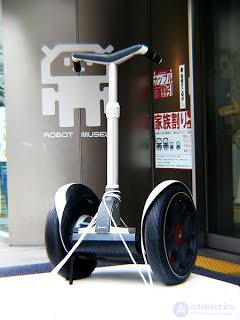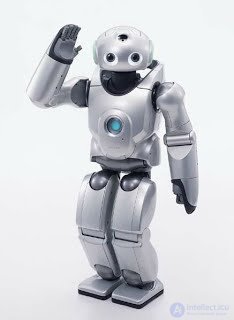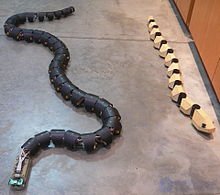Wheel and tracked robots
The most common robots of this class are four-wheel and tracked robots. Robots are also created that have a different number of wheels — two or one. Such solutions make it possible to simplify the design of the robot, as well as to give the robot the opportunity to work in spaces where the four-wheel design turns out to be inoperable.
Two-wheeled robots, as a rule, use one or another gyroscopic device to determine the angle of inclination of the robot body and the generation of the corresponding control voltage supplied to the robots' drives (in order to maintain balance and perform the necessary movements). The task of maintaining the balance of a two-wheeled robot is related to the dynamics of the inverse pendulum. At the moment, developed many of these "balancing" devices. Such devices include Segway, which can be used as a component of the robot; for example, segway is used as a transport platform in a robot developed by NASA Robonavt.

One-wheeled robots largely represent the development of ideas related to two-wheeled robots. To move in 2D space as a single wheel, a ball can be used, driven by several actuators. Several developments of such robots already exist. Examples include the scarabot developed at Carnegie Mellon University, the BallIP scrobot , developed at Tohoku Gakuin University (Eng. Tohoku Gakuin University ), or the Rezero scrobot, developed at the Swiss Higher Technical School. Robots of this type have some advantages associated with their elongated shape, which may allow them to better integrate into the human environment than is possible for some other types of robots.
There are a number of prototypes of spherical robots. Some of them use the rotation of the internal mass to organize the movement. Robots of this type are called English. spherical orb robots , eng. orb bot and eng. ball bot .
To move on uneven surfaces, grass and rocky terrain, six-wheel robots are being developed that have a greater grip than four-wheel robots. Caterpillars provide even greater grip. Many modern combat robots, as well as robots designed to move on rough surfaces, are designed to be tracked. However, it is difficult to use such robots in rooms, on smooth surfaces and carpets. Examples of such robots can serve as a robot developed by NASA. Urban Robot ("Urbie"), developed by iRobot, Warrior and PackBot robots.
Walking robots
The first publications on the theoretical and practical issues of creating walking robots date back to the 1970s and 1980s of the 20th century.
Moving the robot using “legs” is a complex dynamic task. A number of robots moving on two legs have already been created, but these robots cannot yet achieve such a stable movement as is inherent in humans. Also created a lot of mechanisms moving on more than two limbs. Attention to such structures is due to the fact that they are easier to design. Hybrid versions are also offered (like, for example, robots from the movie “I, Robot,” capable of moving on two limbs while walking and on four limbs while running).
Robots that use two legs, as a rule, move well along the floor, and some designs can move along stairs. Traveling over rough terrain is challenging for robots of this type. There are a number of technologies that allow walking robots to move:
- ZMP-technology: ZMP ( Eng. ) (Eng. Zero Moment Point , "point of zero moment") - an algorithm used in robots like the Honda ASIMO company. The on-board computer controls the robot in such a way that the sum of all external forces acting on the robot is directed towards the surface along which the robot moves. As a result, no torque is generated that could cause the robot to fall. This method of movement is not typical for humans, as can be seen by comparing the manner of movement of the ASIMO robot and humans.

- Jumping robots: In the 1980s, Prof. Mark Reibert (Eng. Marc Raibert from Eng. “Leg Laboratory” of MIT) developed a robot capable of maintaining balance through jumping, using only one leg. The movements of the robot resemble human movements on a training simulator later, the algorithm was extended to mechanisms using two and four legs. Such robots demonstrated the ability to run and the ability to perform somersaults. The robots moving on four limbs demonstrated b er, move, pace, jumps.
- Adaptive balance algorithms. Basically they are based on the calculation of deviations of the instantaneous position of the center of mass of the robot from a statically stable position or some kind of predetermined trajectory of its movement. In particular, the Big Dog walking robot carrier uses this technology. When moving, this robot maintains a constant deviation of the current position of the center of mass from the point of static stability, which necessitates a peculiar setting of the legs (“knees inwards” or “pull”), and also creates problems with stopping the machine in one place and working out the transient walking modes. The adaptive algorithm for maintaining stability can also be based on maintaining the constant direction of the velocity vector of the center of mass of the system; however, such techniques are effective only at sufficiently high speeds. The greatest interest for modern robotics is the development of combined sustainability techniques that combine the calculation of the kinematic characteristics of the system with highly efficient methods of probabilistic and heuristic analysis.
Other moving methods
- Flying robots. Most modern aircraft are flying robots, piloted by pilots. Autopilot is able to control the flight at all stages - including takeoff and landing. Unmanned aerial vehicles (UAVs also belong to flying robots; their important subclass is cruise missiles). Such devices have, as a rule, a small weight (due to the absence of a pilot) and can perform dangerous missions; Some UAVs are capable of firing at the command of the operator. UAVs are also being developed that are capable of firing automatically. In addition to the method of movement used by airplanes, flying robots, other methods of movement are used - for example, similar to those used by penguins, stingrays, jellyfish; This method of movement is used by the Air Penguin, Air Ray and Air Jelly robots of the Festo company, or using insect-specific flight techniques such as, for example, RoboBee.

Two snake-like crawling robots. Left is equipped with 64 drives, right - ten.
- Crawling robots. There are a number of development robots moving like snakes, worms, slugs. It is assumed that a similar method of movement can give them the ability to move in narrow spaces; in particular, it is supposed to use such robots to search for people under the rubble of collapsed buildings. Also, snake-like robots capable of moving in water have been developed; An example of such a design is the Japanese robot ACM-R5.
- Robots moving on vertical surfaces. When designing such robots, different approaches are used. The first approach is the design of robots moving like a man climbing a wall covered with protrusions. An example of such a design is the Capuchin robot developed at Stanford University. Another approach is the design of robots moving like geckos. Examples of such robots are Wallbot and Stickybot.
- Floating robots. There are many developments of robots moving in the water imitating the movements of fish. According to some calculations, the efficiency of such a movement can be 80% higher than the efficiency of movement using a propeller. In addition, such structures produce less noise, as well as high maneuverability. This is the reason for the high interest of researchers to robots moving like fish. Examples of such robots are the Robotic Fish robot developed by the University of Essex and the Tuna robot developed for researching and modeling the tuna movement pattern. Also, there are developments of floating robots of other designs. Examples include robots from Festo: Aqua Ray imitating the movement of a stingray and Aqua Jelly imitating the movement of a jellyfish.
-


Comments
To leave a comment
Robotics
Terms: Robotics